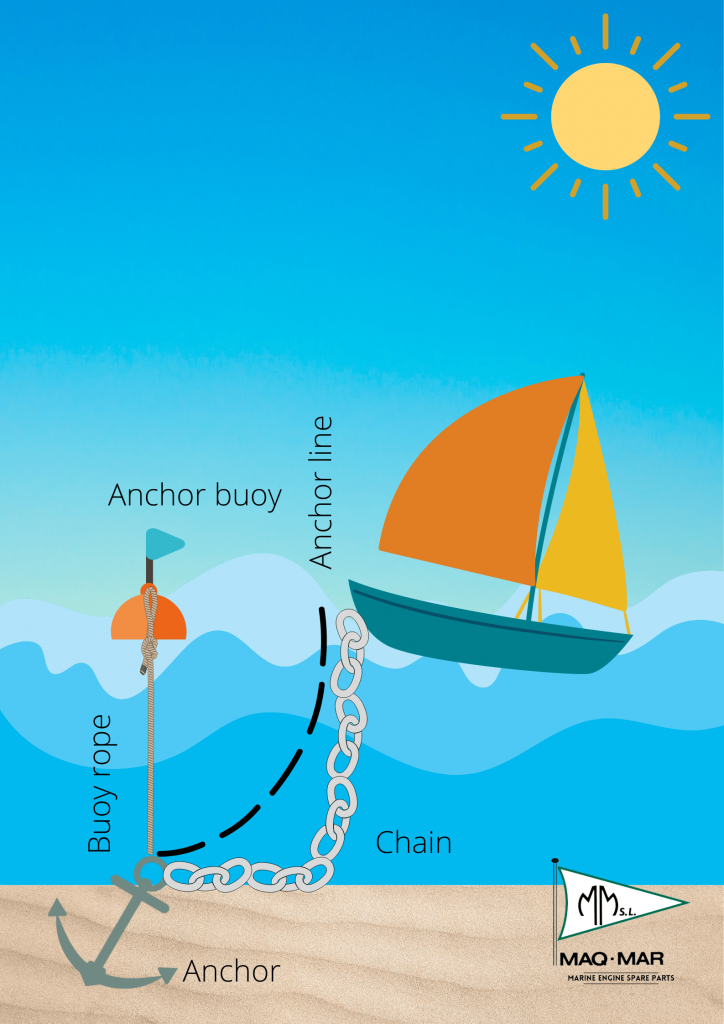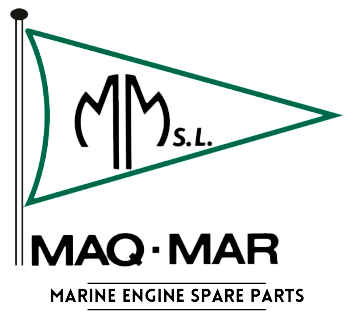Anchoring is one of the most important maneuvers performed on board a ship. Anchoring a ship is the maneuver that consists of mooring the ship to the seabed using an anchor -or dead- connected to a chain, a rope or both. Not only can you dock with an anchor, but it is also possible to dock with a buoy. In fact, the number of buoy fields has increased in recent years in order to preserve the aquatic plant posidonia, especially in the Mediterranean Sea.
Previous considerations of anchoring a ship
Anchoring is done in anchorages, whether they are beaches, coves or bays. Anchoring should only be done in areas authorized for anchoring with anchor or buoy, and never in properly marked bathing areas.
The maneuver must be planned well in advance in order to prepare for it and avoid losing control of the ship. Likewise, anchoring is done considering the wind direction and the orientation of the ship.
In addition, it is necessary to know what kind of seabed there is in the place where we will perform the anchoring maneuver: sand, stones, seaweed, etc. The ideal type of seabed to get a good grip is sandy. But, be careful with the elements that may be on the seabed: obstacles, garbage, cables, seaweed, grass, etc.
As for the draft, the ideal is to opt for about 4-8 meters, since below or above this depth the safety of the anchorage is reduced. In addition, it is necessary to consider the high tide, the proximity to the shore and if there are rocks below the surface.
The anchor line
The anchor line is the line that connects the ship to the anchor and is composed of: anchor, line and chain. To calculate the length of the anchor line we must know the depth at which the anchor is, but it cannot be less than five times the length of the ship. Normally, only one main anchor is carried on board, although it is recommended to carry a second anchor in case of any unwanted unforeseen event.
Anchor security is proportional to the amount of chain left on the seabed. Therefore, the chain must fall horizontally and not stacked. The necessary meters of chain should be gradually released, so that the chain is always taut and in line with the anchor. Under normal conditions, the length of the chain should be three times the length of the depth – the distance to the bottom-. However, during strong winds, the chain should be five times the distance marked by the depth sounder. Professionals advise to always carry about 50 meters of chain (on recreational ships) to adapt to all types of situations and environments.
The anchoring maneuver with anchor
To start the maneuver, approach the chosen anchoring place at the lowest possible speed and with the wind on the bow -upwind-, leaving plenty of space with the ships astern.
Start by releasing the anchor along with a few meters of chain until the anchor hits the bottom. Then turn off the engine and let the wind begin to move the ship astern while releasing a few meters of chain, which will be deposited in a straight line. Some people tend to back up while releasing the chain little by little, preventing it from piling up on the bottom. However, there is a risk of snagging the propeller on a buoy line or loose mooring lines.
After performing the maneuver
One of the things to watch out for when at anchor is if the wind direction changes. If you are sailing during the summer months there will probably be quite a few ships closer than you would like. So, when the wind shifts, you need to be aware of the swinging at anchor of the other ships. The swinging at anchor circle is the movement of the ship – by the current or by the wind – that occurs when it is anchored, and which occurs in a circular motion around the anchor. For this reason, it is important to leave a distance equal to the sum of the length plus the amount of chain that has been released. In addition, the distance to the shore or shallow areas, and the presence of visible or hidden objects around the perimeter of the circle of the swinging of anchor should be analyzed.
Once the anchor has hit the bottom, you should wait at least 10-15 minutes to analyze the swinging and the dragging of the anchor. The heaving of a ship is the oscillating movement that occurs because: the anchor is not well moored to the seabed, too little chain has been set or the anchor is on a bad bottom. Ideally, the captain should be able to dive to the anchor to check that it is securely attached and cut if it catches on anything.
Signaling
After the anchoring maneuver, a black sphere should be hoisted to indicate that the ship is at anchor. If it is nighttime, the white anchor light should be turned on. Optionally, a buoy rope, which connects the anchor to a buoy, can be attached to indicate that the anchor is just below.
To control the movement of the ship, an application can be installed on the smartphone -if the ship does not have it integrated- that remembers the location of the ship and the position of the anchor. Based on the length of the chain that is released, it establishes the radius of the safety zone and if it goes out it will issue an alarm.
Anchoring a ship with anchor vs. buoy
Generally, anchoring with a buoy has some advantages over anchoring with an anchor:
- It respects the posidonia on the seabed, a plant that creates oxygen and serves as a refuge for many animal species, as well as filtering the water keeping it clean and transparent.
- There is no swinging or dragging.
- Some buoy camps offer cab service day and night.
But, anchoring with a buoy also has its disadvantages compared to anchoring with an anchor:
- Some buoys are free, but others are not.
- You have to plan your anchorage in advance to reserve a spot.
- The good condition of the buoy does not depend on the sailors.
Obviously, both anchoring options are valid, with their pros and cons. Each sailor will choose the most appropriate one depending on the conditions and circumstances of the moment. In any case, the environment, marine life and other neighboring ships must always be respected.
If you want to know more about us or our products, you can contact us or follow us on LinkedIn to keep up to date with all the news.


Recent Comments